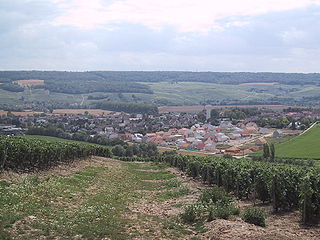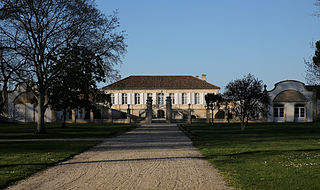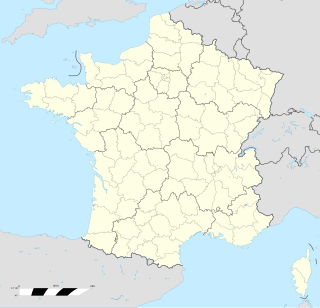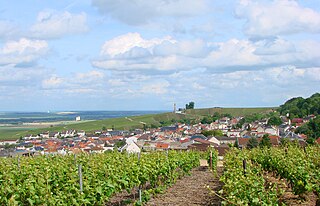
The Champagne wine region is a wine region within the historical province of Champagne in the northeast of France. The area is best known for the production of the sparkling white wine that bears the region's name. EU law and the laws of most countries reserve the term "Champagne" exclusively for wines that come from this region located about 160 kilometres (100 miles) east of Paris. The viticultural boundaries of Champagne are legally defined and split into five wine-producing districts within the historical province: Aube, Côte des Blancs, Côte de Sézanne, Montagne de Reims, and Vallée de la Marne. The towns of Reims and Épernay are the commercial centers of the area. Reims is famous for its cathedral, the venue of the coronation of the French Kings and a UNESCO World Heritage Site.

Aÿ is a former commune in the Marne department in northeastern France. On 1 January 2016 it was merged into the new commune Aÿ-Champagne.
The 4 arrondissements of the Marne department are:
- Arrondissement of Châlons-en-Champagne, with 150 communes. The population of the arrondissement was 109,916 in 2016.
- Arrondissement of Épernay, with 210 communes. The population of the arrondissement was 120,269 in 2016.
- Arrondissement of Reims, with 143 communes. The population of the arrondissement was 294,674 in 2016.
- Arrondissement of Vitry-le-François, with 110 communes. The population of the arrondissement was 46,024 in 2016.

The arrondissement of Épernay is an arrondissement of France in the Marne department in the Grand Est region. It has 210 communes. Its population is 120,269 (2016), and its area is 2,722.4 km2 (1,051.1 sq mi).
Gosset, founded in 1584, is the oldest wine house in Champagne. In 1584, Pierre Gosset, alderman of Aÿ and wine-grower, made still, mostly red, wines from the grapes he harvested from his own vines. In those days, two wines vied for pride of place at the table to the Kings of France: the wine of Aÿ and, from some hundreds of leagues further South, the wine of Beaune. Then, in the 18th century the wine made in around Aÿ began to bubble and the Gosset family turned naturally to the production of champagne.

The Champagne Riots of 1910 and 1911 resulted from a series of problems faced by grape growers in the Champagne area of France. These included four years of disastrous crop losses, the infestation of the phylloxera louse, low income and the belief that wine merchants were using grapes from outside the Champagne region. The precipitating event may have been the announcement in 1908 by the French government that it would delimit by decree the exact geographic area that would be granted economic advantage and protection by being awarded the Champagne appellation. This early development of Appellation d'Origine Contrôlée regulation benefitted the Marne and Aisne districts to the significant exclusion of the Aube district which included the town of Troyes—the historic capital of the Champagne region.

Bollinger is a Champagne house, a producer of sparkling wines from the Champagne region of France. They produce several labels of Champagne under the Bollinger name, including the vintage Vieilles Vignes Françaises, Grande Année and R.D. as well as the non-vintage Special Cuvée. Founded in 1829 in Aÿ by Hennequin de Villermont, Paul Renaudin and Jacques Bollinger the house continues to be run by members of the Bollinger family. In Britain Bollinger Champagnes are affectionately known as "Bolly".

Château La Lagune is a winery in the Haut-Médoc appellation of the Bordeaux region of France. The wine produced here was classified as one of fourteen Troisièmes Crus in the historic Bordeaux Wine Official Classification of 1855.

Mareuil-sur-Ay is a former commune in the Marne department in north-eastern France. Since January 2016, Mareuil-sur-Aÿ is part of the administrative commune Aÿ-Champagne.
Kiix-in, or Kiix?in , earlier romanized as Keeshan, was the principal residence of the Huu-ay-aht (Ohiaht) group of the Nuu-chah-nulth people. The name is onomatopoeic, and comes from the sound of waves crashing against the rocks below the village. It was initially romanised as "Keeshan", but was redesignated "Kiix-in " in line with the Maa-nulth Treaty.

The history of Champagne has seen the wine evolve from being a pale, pinkish still wine to the sparkling wine now associated with the region. The Romans were the first to plant vineyards in this area of northeast France, with the region being cultivated by at least the 5th century, possibly earlier. When Hugh Capet was crowned King of France in 987 at the cathedral of Reims, located in the heart of the region, he started a tradition that brought successive monarchs to the region—with the local wine being on prominent display at the coronation banquets. The early wine of the Champagne region was a pale, pinkish wine made from Pinot noir.
Jacquesson & Fils is a Champagne producer based in the Dizy region of Champagne. The house was founded in Châlons-sur-Marne in 1798 by Memmie Jacquesson. The house makes the claim it is the oldest independent Champagne house.

A clos is a walled vineyard. Walled vineyards protected the grapes from theft and may improve the mesoclimate. They were often the vineyards of Cistercian monasteries. The word is often used in the name of famous wines even when the wall no longer exists.

Aÿ-Champagne is a commune in the Marne department, northern France. The municipality was established on 1 January 2016 and consists of the former communes of Aÿ, Mareuil-sur-Aÿ and Bisseuil. The three former communes keep their names and town halls.

Montagne de Reims Regional Natural Park is a protected area in the Grand Est region of France. It is organized around the Montagne de Reims, a wooded range of hills covered by vineyards that produce the region's eponymous sparkling wine, Champagne.
The canton of Épernay-1 is an administrative division of the Marne department, northeastern France. Its borders were modified at the French canton reorganisation which came into effect in March 2015. Its seat is in Épernay.

Vallée de la Marne is a sub-region of the Champagne wine region. It is south of Champagne and Montagne de Reims, and north of Côte de Sézanne and Côte des Blancs. The sub-region is located on the riverbanks of the Marne. Its soils are more variable than in other Champagne sub-regions, and it contains only two Grands Crus villages: Ay and Tours-sur-Marne. Pinot Meunier is the main grape variety.
Pierre Gimonnet & Fils is a Grower Champagne producer and an original member of the Club Trésors de Champagne. The domaine has 28 hectares based in the Côte des Blancs with Premier cru sites in Cuis and Mareuil-sur Aÿ, and Grand crus in Cramant, Chouilly, Oger, Vertus, and Aÿ; the fields are planted to 98% chardonnay and 2% pinot noir. The house produces 20,000 cases annually. The house is noted for old vines, with 70% over 30 years old, and even century-old vines in the Grand Cru lieux-dits of Le Fond du Bateau and Buisson. Three generations of the family have produced Champagne; today, the estate is managed by Didier and Olivier Gimonnet.
Henri Goutorbe is a Grower Champagne and member of Club Trésors de Champagne. The 25 hectares of vines located in Vallée de la Marne produce 15,000 cases annually. The vineyards are planted to 70 percent pinot noir, 27 percent chardonnay and three percent pinot meunier. The family has Premier cru sites in Mareuil-sur-Ay, Mutigny and Bisseuil, and a Grand cru site in Aÿ.












